In the 6,000-year-old Kültepe Kaniş Karum Ruins in Kayseri, where work has been ongoing since 1948, the symbols of religious belief will be revealed during the excavations that will begin in June.

Ankara University Faculty of Language, History-Geography, Archeology Department faculty member Prof. Dr. Fikri Kulakoğlu said, “We will try to reveal the rest of the religious belief symbols that we found in the buildings 4,500 years ago, before the Assyrian merchants. If we can, we would like to contribute to the Kayseri Museum by reaching a merchant’s archive and house in the works we will do in Karum.”

Kültepe Kaniş-Karum Ruins, where documents that date Kayseri’s history back 6,000 years, are located 24 kilometers from the city center. There are administrative buildings, religious buildings, houses, shops and workshop ruins in Kültepe Ruins, which consists of the mound, the remnant of the first city founded by the Hittites in Anatolia, and Karum surrounding it. Excavation, restoration and inventory works at the ruins, which is one of the important tourism centers of Turkey, have been continuing since 1948. The excavation works, which were suspended due to the winter season, will start in June.
‘THERE IS VERY SPECIAL DATA WE DISCOVERED IN KÜLTEPE’

Excavation Director Prof. Dr. Fikri Kulakoğlu gave information about the excavations and said, “We will start the 2021 works soon. As you know, Kültepe is included in the 12-month excavation program. This year, I think there will be a longer period of excavation work than last year. When we start excavations at the beginning of this June, we will excavate until October. Of course, excavation is not only digging in the field, but apart from that, we know that the work continues in the camp. Artifacts, objects and records found during excavations are handled and stored. This year it will take place mainly on the hill. Before these Assyrian merchants arrived, we are working on the hill to understand earlier periods. These studies yield interesting results. Actually, what we have discovered so far in Kültepe is very special data. Indeed, it is closely followed not only in Turkey, but also in the international community. Therefore, we somehow get the result of the work we do here.”
‘WE ARE SEPARING THE PERIODS WHERE THE ASSURIA MERCHANTS COME’

Prof. Dr. Kulakoğlu said the works will be carried out in an area called the Old Bronze Age and used the phrases; “There were nearly 100 statues made of water marble that we called ‘idol’ that we found before. We will continue to work in that area. If we can discover it, we will have unearthed a very special area. However, not only these periods, but in fact, we do not know when Kültepe was first settled. Again for this purpose, we had a test sounding on the mound on the shore of the Varshama Palace. We want to continue working there. We saw last year that we would reveal earlier periods there. We plan to do this. We distinguish between the period before the Assyrian merchants came and the period after their arrival. I hope this year, both the possibilities and the pandemic will allow it.”
‘WE WILL SOLVE SOME FACTS HERE THAT WE DON’T KNOW IN SYRIA’

Prof. Dr. Kulakoğlu stated that Kültepe is an important building and said, “Kültepe is an important center that illuminates today, especially 4 thousand years ago. The tablets with cuneiform scripts show this to us. The information here does not only illuminate Kültepe. It gives important findings about Syria’s 2000 BC. In fact, the excavations we are doing now will yield findings dating back to 3,000 years. In other words, we will have solved some events here, that we did not know about in Syria. At the same time, the tablets in Kültepe give the unknowns of the period in the region, which includes a large part of Iraq, which we call Mesopotamia today. It is extremely important in terms of illuminating the world history at that time. Of course, when the tablets here are read, it is definitely beneficial. It gives us a lot of historical information. In fact, we are talking about a trade that was not done at that time.”
‘WE ARE PURSUANT TO THE DATA, NOT THE ARTIFACT’
Noting that they will carry out two important works this year, Kulakoğlu said, ”This year, we will work in two different places. In fact, if you look at it, we are pursuant to the data, not the artifact. In other words, we call it tracking because those artifacts will give us data. First, we will try to reveal the rest of the symbols of religious belief that we found earlier in the structures belong to 4,500 years ago, before the Assyrian merchants. In addition to these, other materials that will be released will certainly be extremely valuable for us. If we can, we want to contribute to the Kayseri Museum with rich finds by reaching a merchant’s archive and house in the works we will do in Karum.” (archaeologyart)